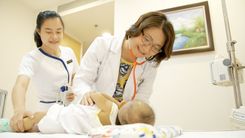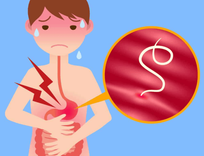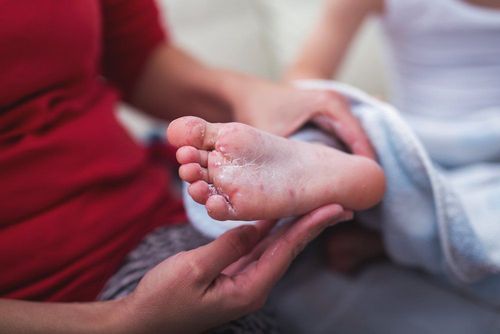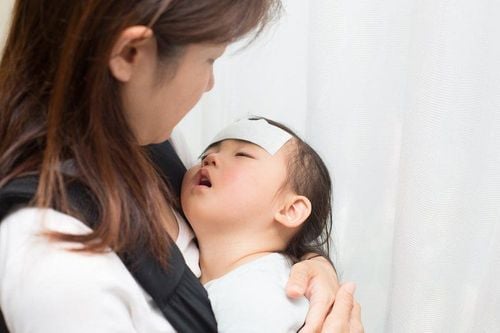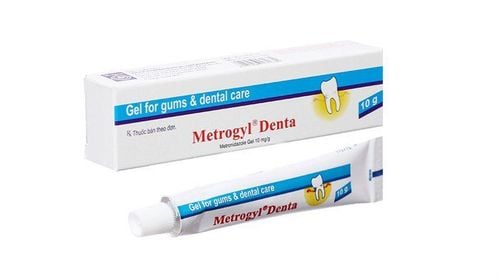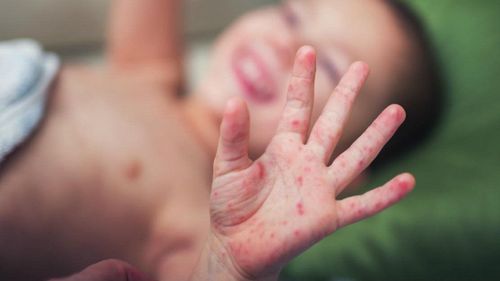Hand, foot, and mouth disease is a dangerous infectious disease that can lead to many complications in children. Therefore, many parents are very concerned when their child contracts HFMD. How long does it take for a child to recover, and what are the signs that the child is healing?
1. What is hand, foot, and mouth disease?
Hand, foot, and mouth disease (HFMD) is an infectious illness caused by enteroviruses with a high rate of transmission. The primary mode of transmission is through contact with saliva, respiratory secretions, or feces of individuals infected with the virus.
Hand, foot, and mouth disease (HFMD) primarily affects children under 5 years old, as their immune systems are not yet fully developed. However, this infectious disease can also occur in teenagers and adults. Most children with HFMD recover on their own within 7-10 days. However, in some cases, if the virus infection is accompanied by abnormal symptoms and left untreated, it may progress to severe complications, such as paralysis, meningitis, and even death.
In Vietnam’s humid and warm climate, HFMD can occur year-round. However, two peak periods of outbreaks occur when the virus thrives, specifically from March to May and from September to December. High-risk environments for HFMD transmission include daycare centers, playgrounds, parks…
The causative agents of hand, foot, and mouth disease (HFMD) include Coxsackievirus (most commonly strain A16) and Enterovirus 71. The virus spreads directly from person to person, primarily through contact with infected individuals or virus carriers, including:
- Contact with fluid from broken blisters;
- Contact with the feces of infected individuals;
- Contact with saliva or nasal secretions after an infected person coughs or sneezes;
- Direct contact with unwashed hands or surfaces contaminated by the infected person in a short period of time.
2. Signs of Hand, Foot, and Mouth Disease in Children
Before identifying the signs of recovery from hand, foot, and mouth disease, we need to understand the stages of this dangerous illness:
- Incubation Period: The virus causing hand, foot, and mouth disease can incubate for about 3-7 days without causing any symptoms.
- Initial Stage: Lasts about 1-2 days with symptoms such as mild fever, poor appetite, increased fatigue, and in some cases, diarrhea.
- Full-Blown Stage: Lasts from 3-10 days with the typical symptoms of hand, foot, and mouth disease, such as:
- Mouth Ulcers: Small red ulcers, often accompanied by fluid-filled blisters (2-3mm in diameter), develop on the child’s mucous membranes. These ulcers can become infected, causing pain, leading to poor feeding, refusal to eat or breastfeed, and increased drooling.
- Skin Lesions: Typical skin rashes appear as water-filled blisters located on areas such as the palms of the hands, soles of the feet, knees, and buttocks. These lesions usually last for less than 7 days and leave dark marks when healed, rarely becoming infected.
- Mild Fever: Children with high fever may indicate potential complications of hand, foot, and mouth disease.
- In some cases, the full-blown stage may be accompanied by dangerous complications involving the nervous, circulatory, or respiratory systems.
- Recovery Stage: Many parents wonder how long it takes for hand, foot, and mouth disease to resolve. In a typical course of HFMD, if no complications arise, the child enters the recovery stage, which usually lasts 3-5 days. Signs of recovery from hand, foot, and mouth disease include improved overall health, complete resolution of symptoms, and no lasting complications.
Corresponding to the four stages of the disease, hand, foot, and mouth disease (HFMD) is classified into four levels of severity as follows:
- Level 1 HFMD: This is the mildest form of the disease, with symptoms limited to mouth ulcers and/or skin lesions.
- Level 2a HFMD: In addition to mouth ulcers and skin lesions, the child may show one of the following signs: Startling less than 2 times in 30 minutes and not observed during the examination, high fever over 39°C, fever lasting more than 2 days, frequent vomiting, changes in consciousness, such as lethargy or unexplained irritability.
- Levels 2b to 3 and 4 HFMD: These levels indicate more severe forms of the disease, with the potential for dangerous complications that can seriously impact the child's health.
See more: Signs of severe hand, foot, and mouth disease.
3. What to Do When a Child Has Hand, Foot, and Mouth Disease?
Hand, foot, and mouth disease (HFMD) is a viral infectious illness, and there is currently no specific treatment. The principles of treating HFMD mainly focus on symptom management, improving the child’s condition, and preventing and treating complications (especially circulatory and respiratory failure).
Measures to Reduce HFMD Symptoms in Children:
- Use appropriate pain relievers and fever-reducing medications;
- Rinse the child’s mouth with warm diluted salt water;
- Ensure the child gets plenty of rest and stays hydrated;
- Provide a diet with soft foods that are easy to swallow, and avoid spicy, hot, sour, or salty foods to prevent worsening mouth ulcers;
- Do not share personal items with infected individuals, and temporarily isolate the child to prevent the disease from spreading;
- If any abnormal signs appear, parents should quickly take the child to the hospital for timely examination, diagnosis, and treatment to avoid serious health risks.
See more: 3 warning signs of severe hand, foot, and mouth disease in young children.
4. How Long Does It Take for a Child with Level 1 HFMD to Recover?
Among the levels of hand, foot, and mouth disease (HFMD), Level 1 is the mildest form. It can be treated on an outpatient basis with follow-up appointments as scheduled by the doctor. Typically, children diagnosed with Level 1 HFMD need to be re-examined every 1-2 days during the first 8-10 days to monitor their health and detect any signs of progression to a more severe level.
While Level 1 HFMD can be managed and monitored at home, parents must not be careless. They need to closely observe the following signs and take the child to a medical facility immediately if any occur:
- High fever over 39°C;
- Rapid breathing, difficulty breathing, or use of accessory respiratory muscles;
- Sudden startling during sleep;
- Lethargy, constant unexplained crying, restlessness, or difficulty falling asleep;
- Frequent vomiting;
- Sudden unsteady walking or trembling hands and feet in toddlers;
- Signs of circulatory failure: mottled purple skin, cold hands and feet, excessive sweating;
- Seizures or coma.
How long does it take for Level 1 HFMD to resolve? Most cases resolve on their own within 7 to 10 days without the need for extensive treatment. However, in some specific cases, parents may need additional advice from doctors on supportive treatment or at-home care methods until the child fully recovers from HFMD.
5. How to Prevent Hand, Foot, and Mouth Disease?
Currently, there is no vaccine to prevent hand, foot, and mouth disease (HFMD). Therefore, implementing measures to prevent the spread of the virus in the community is essential:
- HFMD easily spreads in community settings, especially in places with many children, such as daycares, kindergartens, schools, and children’s play areas.
- Maintain strict personal hygiene, including thorough handwashing with soap, especially after handling diapers, clothing, or any bodily fluids from infected individuals.
- Maintain good food hygiene, ensure the use of clean water, eat well-cooked food, drink boiled water, and clean utensils before use.
- Adults should not pre-chew food for children, do not let children eat with their hands, suck their thumbs, or put toys in their mouths.
- Do not share personal items with others unless they have been properly disinfected.
Regularly clean toys, household items, and floors, especially in households with young children.
Do not allow children to come into contact with infected individuals or those showing signs of HFMD.
In summary, parents must remain vigilant. If, after the full-blown stage, the child shows no signs of recovery, their overall condition does not improve, or symptoms fail to subside, take the child to the hospital immediately for medical assistance. Do not be negligent under any circumstances.
As a key focus area of the Vinmec Healthcare System, the Pediatrics Department is systematically invested in terms of personnel, technology, and equipment, ensuring customer satisfaction.
- Top Pediatric Specialists: Vinmec brings together experienced professors, associate professors, doctors, and masters who have worked at major hospitals across the country and received professional training both domestically and internationally. They also deeply understand children’s psychology. Comprehensive Services: Vinmec offers a full range of continuous healthcare services, including Newborn care, Pediatrics, and Vaccination in accordance with international standards, partnering with parents to take care of their child’s health from birth to adulthood.
- Advanced Techniques: Vinmec has successfully implemented many advanced techniques to effectively treat complex pediatric diseases, such as neurosurgery, cranial surgery, and hematopoietic stem cell transplantation for cancer treatment.
- Professional Care: Understanding children’s psychology, Vinmec has created play areas for kids to make them feel comfortable, adapt to the hospital environment, and cooperate in treatment, thus improving the efficiency of medical care.
To schedule an examination or treatment with Vinmec’s pediatric doctors at Vinmec International General Hospitals nationwide, please click the "Contact" button on the website or register for an online consultation.
To arrange an appointment, please call HOTLINE or make your reservation directly HERE. You may also download the MyVinmec app to schedule appointments faster and manage your reservations more conveniently.
